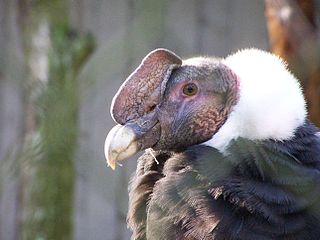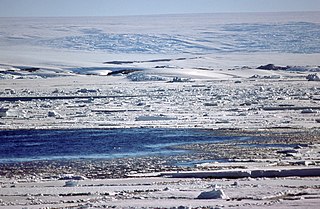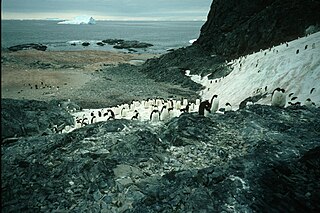
The Antarctic Treaty and related agreements, collectively known as the Antarctic Treaty System (ATS), regulate international relations with respect to Antarctica, Earth's only continent without a native human population. It was the first arms control agreement established during the Cold War, designating the continent as a scientific preserve, establishing freedom of scientific investigation, and banning military activity; for the purposes of the treaty system, Antarctica is defined as all the land and ice shelves south of 60°S latitude. Since September 2004, the Antarctic Treaty Secretariat, which implements the treaty system, is headquartered in Buenos Aires, Argentina.
The Protocol on Environmental Protection to the Antarctic Treaty, also known as the Madrid Protocol, is a complementary legal instrument to the Antarctic Treaty signed in Madrid on 4 October 1991. It entered into force on 14 January 1998.
This is an index of conservation topics. It is an alphabetical index of articles relating to conservation biology and conservation of the natural environment.

The BernConvention on the Conservation of European Wildlife and Natural Habitats, also known as the Bern Convention, is a binding international legal instrument in the field of Nature Conservation, it covers the natural heritage in Europe, as well as in some African countries. The Convention was open for signature on 19 September 1979 and came into force on 1 June 1982. It is particularly concerned about protecting natural habitats and endangered species, including migratory species.

The China–Australia Migratory Bird Agreement (CAMBA) is a bilateral treaty between Australia and China that aims to protect migratory birds and their environment between the two countries. Throughout all six Articles, the treaty defines what a migratory bird is, outlines key prohibitions for both contracting parties and determines the responsibilities of both nations to protect migratory birds and their habitats. The CAMBA was first developed on 20 October 1986, and came into force on 1 September 1988. Eighty-one bird species are listed in the agreement, as shown in the CAMBA Annex listed below.
The Migratory Bird Treaty Act of 1918 (MBTA), codified at 16 U.S.C. §§ 703–712, is a United States federal law, first enacted in 1918 to implement the convention for the protection of migratory birds between the United States and Canada. The statute makes it unlawful without a waiver to pursue, hunt, take, capture, kill, or sell nearly 1,100 species of birds listed therein as migratory birds. The statute does not discriminate between live or dead birds and also grants full protection to any bird parts, including feathers, eggs, and nests. A March 2020 update of the list decreased the number of species to 1,093.

The Scientific Committee on Antarctic Research (SCAR) is an interdisciplinary body of the International Science Council (ISC). SCAR coordinates international scientific research efforts in Antarctica, including the Southern Ocean.

The Antarctic Conservation Act, enacted in 1978 by the 95th United States Congress, and amended by Pub. L.Tooltip Public Law 104–227 (text)(PDF), is a United States federal law that addresses the issue of environmental conservation on the continent of Antarctica. The Departments of the Treasury, Interior and Commerce are responsible for the Act's enforcement.

The Antarctic Treaty Secretariat (ATS) is a subsidiary body of the Antarctic Treaty Consultative Meeting (ATCM) and, as such, performs its duties under the ATCM's direction. The ATCM is the forum that brings together the Antarctic Treaty Consultative Parties, Non-Consultative Parties, Observers and Experts. The Antarctic Treaty was signed in 1959 and entered into force in 1961.

Cape Shirreff is a prominent cape at the north end of the rocky peninsula which separates Hero Bay and Barclay Bay on the north coast of Livingston Island, in the South Shetland Islands of Antarctica. The cape was named by Edward Bransfield in 1820 after Captain William H. Shirreff, the British commanding officer in the Pacific at that time.

Murray Monolith is a detached part of Torlyn Mountain in Mac.Robertson Land, Antarctica. It is a steep massif of metasedimentary gneiss and granitic origin, with the adjacent coastline consisting of 40 m high ice cliffs. The monolith is dome-shaped with steep sides, rising to a seaward summit of 339 m and an inland summit of 363 m at Torlyn Mountain.

Byers Peninsula is a mainly ice-free peninsula forming the west end of Livingston Island in the South Shetland Islands of Antarctica. It occupies 60 km2 (23 sq mi), borders Ivanov Beach to the northeast and is separated from Rotch Dome on the east by the ridge of Urvich Wall. The peninsula features more than 60 meltwater streams and as many lakes, notably Midge Lake, Limnopolar Lake and Basalt Lake. Byers Peninsula has a regime of special environmental protection under the Antarctic Treaty System and requires a permit to enter.

The wildlife of Chile is very diverse because of the country's slender and elongated shape, which spans a wide range of latitude, and altitude, ranging from the windswept coastline of the Pacific coast on the west to northern Andes to the sub-Antarctic, high Andes mountains in the east. There are many distinct ecosystems.

Coppermine Peninsula is the rugged, rocky promontory forming the northwest extremity of Alfatar Peninsula and Robert Island in the South Shetland Islands, Antarctica. It lies between the English Strait to the west and Carlota Cove to the east. It is 1.7 km long, 500 m wide and rising to 105 m.

Port Martin, or Port-Martin, is an abandoned French research base at Cape Margerie on the coast of Adélie Land, Antarctica, as well as the name of the adjacent anchorage.

Half Moon Beach is a small crescent-shaped beach lying 1 nautical mile (2 km) south-east of Scarborough Castle on the north coast of Livingston Island, in the South Shetland Islands of Antarctica. The beach lieas at the western extremity of Porlier Bay in the north of Ioannes Paulus II Peninsula.

Lagotellerie Island is an island 1.9 kilometres (1 nmi) long, lying 3.7 kilometres (2 nmi) west of Horseshoe Island in Marguerite Bay, off the west coast of Graham Land, Antarctica. It was discovered and named by the French Antarctic Expedition, 1908–10, under Jean-Baptiste Charcot.
An Antarctic Protected Area is an area protected under the Antarctic Treaty System. There are three types of Protected Areas under this system:
The Convention for the Protection and Development of the Marine Environment of the Wider Caribbean Region, commonly called the Cartagena Convention, is an international agreement for the protection of the Caribbean Sea, the Gulf of Mexico and a portion of the adjacent Atlantic Ocean. It was adopted on 24 March 1983, entered into force on 11 October 1986 subsequent to its ratification by Antigua and Barbuda, the ninth party to do so, and has been ratified by 26 states. It has been amended by three major protocols: the Protocol Concerning Co-operation in Combating Oil Spills in the Wider Caribbean Region, the Protocol Concerning Specially Protected Areas and Wildlife to the Convention for the Protection and Development of the Marine Environment of the Wider Caribbean Region and the Protocol Concerning Pollution from Land-Based Sources and Activities to the Convention for the Protection and Development of the Marine Environment of the Wider Caribbean Region.














